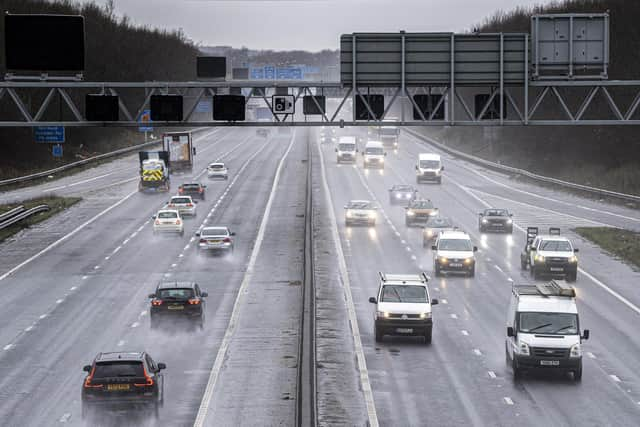A rethink is needed on how Britain utilises roads to improve the flow of traffic - Sir Andrew Cook
Yes, even I, a great fan of the train, have been compelled by the sheer quantity of my wife’s luggage to take a taxi from Heathrow airport into London. All has gone well for the first five miles, but now we are stuck.
The reason is obvious. This eternally busy motorway funnels down from three lanes to two before petering out altogether as it becomes the Cromwell Road, an urban thoroughfare littered with all the panoply of hazards – traffic lights, crossings etc. – to impede smooth traffic flows.
Advertisement
Hide AdAdvertisement
Hide AdSurely a lesson can be learned from the railways? At last we have Crossrail. Why not Crossroad? England used to lead the world in advanced transport schemes. The London Underground system was begun in the mid-19th century as an inspired solution to chronic traffic congestion. It has proved indispensable.


So, if trains in tunnels work, why not cars in tunnels? Instead of the M4 fizzling out as it does, why not tunnel down under the Cromwell Road and keep going, right under the heart of the city, exiting the other side somewhere around Canary Wharf? Exit spurs from the main tunnel would serve key surface locations such as Hyde Park Corner and Bank.
There is nothing new in such a scheme. Any visitor to the cities of Brussels or Madrid can see how their urban motorways do exactly that, burrowing under the town centre with entrances and exits at strategic points. It works. “How do I get out of Brussels?” I asked a Belgian friend years ago. “Just get into the tunnel system and follow the signs,” he said. It was so simple.
Yes, of course there is still surface traffic, but the mind-numbing queues which any regular user of every motorway entering London has to suffer, are largely eliminated. The almost permanently congested M25 would also experience some relief, the motorist being able to choose whether to cross London or go round it.
Advertisement
Hide AdAdvertisement
Hide AdDoubtless such a proposal would meet with howls of protest from the usual quarters. ‘Cost!’ will wail the government of the day, ignoring the fact that the costs of all great infrastructure projects are forgotten in a few years, especially if, unlike the ‘white elephant’ that HS2 promises to be, the end result is useful.
‘Pollution,’ protest the climate warriors, oblivious to the reality that cars stuck motionless with their engines running pollute more than cars actually moving. ‘Use the trains and buses,’ cry those opposed to private car ownership, forgetting that sometimes the train and bus can’t satisfy the traveller’s needs.
Doubtless the London aquifer and the clay-dwelling newt (I’ve made that up) will be prayed in aid of the ‘Stop Crossroad’ campaign. Traffic disruption during the construction period is another bullet the ‘antis’ will fire. To all of which I answer, ‘sometimes you have to break eggs to make an omelette. It’s called progress’.
Which brings me back to the east-west Crossrail. At last, it’s happened. Pity it misses the main London terminals of Kings Cross/St Pancras and Euston, but better that than nothing. Now we need Crossrail 2 – the north-south link, and while building that, incorporate Crossroad 2 into the construction programme and kill two birds with one stone.
Advertisement
Hide AdAdvertisement
Hide AdBut what of Yorkshire? Putting aside the argument that ‘what’s good for London is good for the country as a whole’, I would be willing to abandon the entire Crossroad project in exchange for a radically improved route across Woodhead.
For decades, trans-Pennine road traffic has been constrained by the absurdly congested A628. Again, we have the curse of a fast motorway coming to an abrupt end, in the east, at Stocksbridge, in the west, at Mottram. In between, a narrow twisty road more typical of the Yucatan than Yorkshire struggles to cope with its massive overload.
Yet again, the heavy hand of the ‘can’t afford, can’t do’ Treasury and Department for Transport (DfT) can be seen when passing the never-built Junction 35B on the M1 motorway.
This was intended to be the intersection with the east-west (south) trans-Pennine motorway, supplementing the M62 and providing a much needed direct connection between the M18 and the M60. Were it that the Treasury mandarins and DfT apparatchiks had to endure this as their daily commute. They would soon change their tune.
Advertisement
Hide AdAdvertisement
Hide AdSo what can still be done without tearing up half the moors and enraging the conservationists?
The answer lies in Italy, where road improvement schemes have been skilfully blended into attractive environments by taking the old road and converting it into a single one-way carriageway, while building the other carriageway, often at a considerable distance from the first, along a visually favourable alignment. Concerned British politicians should visit the Turin-Salerno motorway to see how it’s been done.
Over Woodhead, the basis of such a scheme is already there. The existing A628, with suitable improvements including the long-overdue Hollingworth bypass, would serve as the eastbound carriageway, while the disused track-bed of the former Woodhead railway would become the westbound carriageway. No tearing up of moorland. Minimal disruption.
Sir Andrew Cook is a British industrialist.
Comment Guidelines
National World encourages reader discussion on our stories. User feedback, insights and back-and-forth exchanges add a rich layer of context to reporting. Please review our Community Guidelines before commenting.